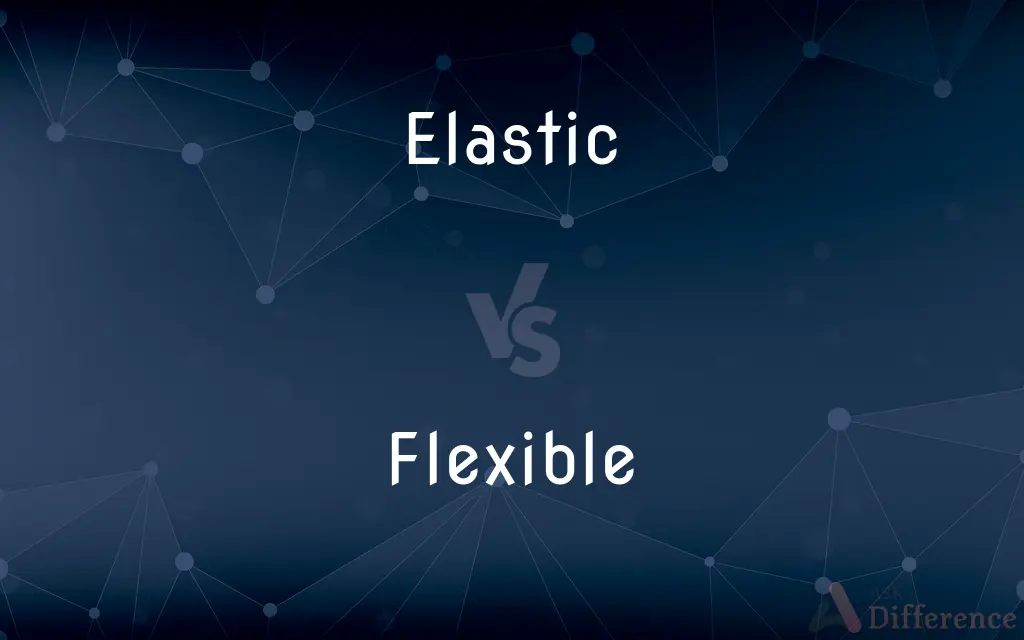Elastic vs. Flexible — What's the Difference?
By Maham Liaqat & Fiza Rafique — Updated on May 2, 2024
"Elastic" refers to the ability of a material to stretch and return to its original shape, focusing on physical deformation, "flexible" describes the ability to bend easily without breaking, emphasizing adaptability without a focus on returning to form.

Difference Between Elastic and Flexible
Table of Contents
ADVERTISEMENT
Key Differences
Elastic materials are specifically noted for their ability to stretch significantly and return to their original dimensions, whereas flexible materials can bend or be manipulated easily but may not necessarily return to their original shape.
The concept of elasticity is often quantified in physics and engineering through measures such as Young's modulus, which describes an object's ability to undergo elastic deformation under stress. On the other hand, flexibility does not have a specific physical metric and is more qualitative, describing a general characteristic.
In practical applications, elastic materials like rubber or spandex are preferred where reformation is crucial after deformation, such as in tires or elastic bands. Conversely, flexible materials such as soft leather or cloth are chosen for their ability to conform to shapes or fold without damage, as seen in upholstery or clothing.
The usage of the terms also differs across disciplines; for instance, in economics, "elastic" refers to variables that are responsive to changes, such as price elasticity, while "flexible" might refer to adaptable policies or systems that can adjust to changes without specific measures of snap-back.
While both properties are valuable in materials science, the key distinction lies in the material's response to stress and its subsequent behavior, with elasticity being a subset of flexible behavior focused on the ability to restore original form after stretching.
ADVERTISEMENT
Comparison Chart
Definition
Ability to be stretched and return to form.
Ability to bend or be twisted without breaking.
Key Characteristic
Return to original shape after deformation.
Conforms easily to shapes without specific recovery.
Physical Metric
Measured by elasticity coefficients (e.g., Young's modulus).
No specific quantitative measure.
Example Materials
Rubber, spandex.
Leather, cloth.
Common Uses
Elastic bands, bungee cords.
Foldable screens, flexible electronics.
Compare with Definitions
Elastic
Made of material that can stretch and return to original length.
Elastic waistbands are preferred for their comfort and fit.
Flexible
Ready and able to change; adaptable.
A flexible approach to problem-solving can often yield the best results.
Elastic
Exhibiting physical resilience.
The elastic band snapped back into place after being stretched.
Flexible
Able to be modified to suit different conditions or uses.
Flexible software platforms allow for extensive customization.
Elastic
Pertaining to economics, responsive to changes in price or demand.
The demand for luxury goods is highly elastic.
Flexible
Not rigid in thinking or behavior.
His flexible attitude makes him a favorite among his peers.
Elastic
Easily resuming original size or shape after being stretched or otherwise deformed; flexible.
Flexible
Materials or designs that accommodate bending or folding.
The flexible design of the phone allows it to fold without damage.
Elastic
Relating to a collision in which the total kinetic energy is conserved.
Flexible
Capable of bending easily without breaking
Flexible rubber seals
Elastic
Quick to recover, as from disappointment; resilient
An elastic spirit.
Flexible
Capable of being bent or flexed; pliable
A flexible hose.
Elastic
Capable of being adapted to change or a variety of circumstances
"To say that morale is a highly unscientific and quite elastic concept would be an understatement" (Roger J. Spiller).
Flexible
Readily bending or twisting the body without injury
You can play soccer much better if you're flexible.
Elastic
(Economics) Of, relating to, or being a good for which changes in price have a large effect on the quantity demanded or supplied.
Flexible
Able to change to cope with variable circumstances
"a flexible and quietly competent administrator" (Jerome Karabel).
Elastic
A flexible stretchable fabric made with interwoven strands of rubber or an imitative synthetic fiber.
Flexible
Capable of being changed or adjusted to meet particular or varied needs
A job with flexible hours.
A flexible definition of normality.
Elastic
An object made of this fabric.
Flexible
Capable of being flexed or bent without breaking; able to be turned or twisted without breaking.
Elastic
A rubber band.
Flexible
Willing or prone to give way to the influence of others; not invincibly rigid or obstinate.
Elastic
Capable of stretching; particularly, capable of stretching so as to return to an original shape or size when force is released.
The rope is somewhat elastic, so expect it to give when you pull on it.
Flexible
Capable or being adapted or molded in some way.
A flexible language
Elastic
Made of elastic.
Elastic band
Flexible
Something that is flexible.
Elastic
Of clothing, elasticated.
Flexible
Capable of being flexed or bent; admitting of being turned, bowed, or twisted, without breaking; pliable; yielding to pressure; not stiff or brittle.
When the splitting windMakes flexible the knees of knotted oaks.
Elastic
(economics) Sensitive to changes in price.
Demand for entertainment is more elastic than demand for energy.
Flexible
Willing or ready to yield to the influence of others; not invincibly rigid or obstinate; tractable; manageable; ductile; easy and compliant; wavering.
Phocion was a man of great severity, and no ways flexible to the will of the people.
Women are soft, mild, pitiful, and flexible.
Elastic
Springy; bouncy; vivacious
Flexible
Capable or being adapted or molded; plastic,; as, a flexible language.
This was a principle more flexible to their purpose.
Elastic
Pervasive, all-encompassing.
Flexible
Extended meanings; capable of change;
A flexible character
Flexible schedules
Elastic
Able to return quickly to a former state or condition, after being depressed or overtaxed; having power to recover easily from shocks and trials.
Elastic spirits; an elastic constitution
Flexible
Able to flex; able to bend easily;
Slim flexible birches
Elastic
(uncountable) An elastic material used in clothing, particularly in waistbands and cuffs.
Running shorts use elastic to eliminate the need for a belt
Flexible
Able to adjust readily to different conditions;
An adaptable person
A flexible personality
An elastic clause in a contract
Elastic
(countable) An elastic band.
Flexible
Bending and snapping back readily without breaking
Elastic
Springing back; having a power or inherent property of returning to the form from which a substance is bent, drawn, pressed, or twisted; springy; having the power of rebounding; as, a bow is elastic; the air is elastic; India rubber is elastic.
Capable of being drawn out by force like a piece of elastic gum, and by its own elasticity returning, when the force is removed, to its former position.
Flexible
Making or willing to make concessions;
Loneliness tore through him...whenever he thought of...even the compromising Louis du Tillet
Elastic
Able to return quickly to a former state or condition, after being depressed or overtaxed; having power to recover easily from shocks and trials; as, elastic spirits; an elastic constitution.
Flexible
Capable of bending easily without breaking.
Flexible copper tubing is often used for plumbing because it can be shaped as needed.
Elastic
An elastic woven fabric, as a belt, braces or suspenders, etc., made in part of India rubber.
Elastic
A narrow band of elastic rubber used to hold things (such as papers) together
Elastic
An elastic fabric made of yarns containing an elastic material
Elastic
Capable of resuming original shape after stretching or compression; springy;
An elastic band
A youthful and elastic walk
Elastic
Able to adjust readily to different conditions;
An adaptable person
A flexible personality
An elastic clause in a contract
Elastic
Able to resume original shape after stretching or compression.
The elastic fabric of her dress allowed it to stretch without tearing.
Elastic
Quickly recovering from or adjusting to change.
The company's elastic strategy helped it survive market fluctuations.
Common Curiosities
What is an example of a flexible but not elastic material?
Soft leather is flexible as it can bend easily but it does not have the inherent property to return to an original shape, which makes it not elastic.
How do elasticity and flexibility contribute to functionality in products?
Elasticity ensures that products like elastic bands and fitness apparel can stretch and recover, enhancing durability and performance, while flexibility allows products like flexible screens to adapt to different forms and uses without damage.
Can a material be both elastic and flexible?
Yes, materials like rubber are both elastic and flexible, able to stretch and return to their original form while bending easily.
Why is flexibility important in electronics?
Flexibility in electronics allows devices like smartphones and tablets to incorporate innovative designs, such as foldable or curved screens, improving portability and usability.
What is the main difference between elastic and flexible?
Elastic materials return to their original shape after being deformed, while flexible materials bend easily without necessarily returning to shape.
Are there specific industries where elasticity is more important than flexibility?
In industries like sports equipment and medical devices, elasticity is crucial because materials must withstand repeated stretching and still recover.
What measures are used to quantify elasticity?
Elasticity is often quantified using measures like the Young’s modulus, which describes the stiffness of an elastic material, and the elasticity coefficient, which measures how a material returns to its original form.
How does temperature affect elasticity and flexibility?
Temperature can significantly affect both properties; higher temperatures generally increase flexibility but may decrease elasticity as materials become less capable of returning to their original shape.
What are the environmental considerations for using elastic materials?
Many elastic materials, such as synthetic rubbers, can be non-biodegradable, posing environmental disposal issues, whereas natural elastic materials like latex are more eco-friendly but often less durable.
How is flexibility enhanced in materials that are naturally rigid?
Flexibility in rigid materials can be enhanced by adding plasticizers, designing materials into thin layers, or engineering composites that combine both rigid and flexible characteristics.
Share Your Discovery

Previous Comparison
Nightclub vs. Restaurant
Next Comparison
Pestilence vs. PetulanceAuthor Spotlight
Written by
Maham LiaqatCo-written by
Fiza RafiqueFiza Rafique is a skilled content writer at AskDifference.com, where she meticulously refines and enhances written pieces. Drawing from her vast editorial expertise, Fiza ensures clarity, accuracy, and precision in every article. Passionate about language, she continually seeks to elevate the quality of content for readers worldwide.
















































